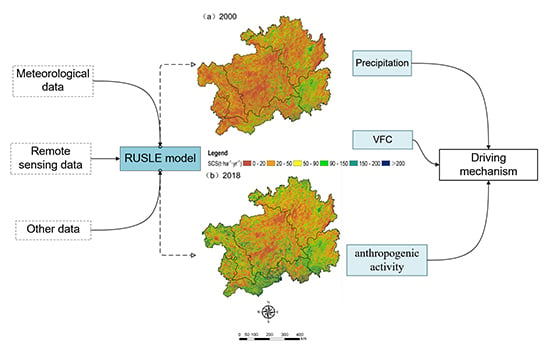Soil Conservation Service Spatiotemporal Variability and Its Driving Mechanism on the Guizhou Plateau, China
Abstract
1. Introduction
2. Materials and Methods
2.1. Study Area
2.2. Data and Processing
2.3. Methods
2.3.1. Soil Conservation Service Simulation
2.3.2. Correlational Analyses
2.3.3. Residual Analysis
3. Results
3.1. Spatial and Temporal Characteristics of SCS
3.1.1. Spatiotemporal Variation of SCS
3.1.2. Spatiotemporal Variation of SCS in Different Landform Regions
3.1.3. Spatiotemporal Variation of SCS in Different Ecological Engineering Areas
3.2. Analysis of Driving Mechanism of SCS
3.2.1. Driving Effect of Precipitation and VFC on SCS
3.2.2. Driving Effect of Anthropogenic Activities on SCS
4. Discussion
4.1. Model Simulations of Soil Erosion Modules and SCS
4.2. Characteristics of SCS
4.3. Driving Mechanism of SCS Under the Effects of Ecological Engineering
4.4. Deficiencies and Prospects
5. Conclusions
Author Contributions
Funding
Acknowledgments
Conflicts of Interest
References
- Daily, G.; Alexander, S.; Ehrlich, P.; Goulder, L.; Lubchenco, J.; Matson, P.A.; Mooney, H.; Postel, S.; Schneider, S.H.; Tilman, D. Ecosystem Services: Benefits Supplied to Human Societies by Natural Ecosystems. Ecological 1997, 1, 1. [Google Scholar]
- GaoDi, X.I.E.; Yu, X.; ChunXia, L.U. Study On Ecosystem Services: Progress, Limitation And Basic Paradigm. Acta Phytoecol. Sin. 2006, 30, 191–199. [Google Scholar]
- Heping, H.; Jie, Y.; Yingbiao, Z.H.I. Assessment for Soil Conserv. Functions and Service Values of Afforested Vegetation by Enclosure in Huangfuchuan Watershed. Bull. Soil Water Conserv. 2008, 28, 173–177. [Google Scholar]
- Wu, D.; Zou, C.; Lin, N.; Cao, W. Temporal and Spatial Variations of Soil Conserv. Service Function in Yangtze River Economic Belt. Bull. Soil Water Conserv. 2018, 38, 144–148. [Google Scholar]
- Chen, N.; Chen, M.; Li, J.; He, N.; Deng, M.; Tanoli, J.I.; Cai, M. Effects of human activity on erosion, sedimentation and debris flow activity—A case study of the Qionghai Lake watershed, southeastern Tibetan Plateau, China. Holocene 2015, 25, 973–988. [Google Scholar] [CrossRef]
- Liu, Y.; Zhao, W.; Jia, L. Soil conservation service: Concept, assessment, and outlook. Acta Ecol. Sin. 2019, 39, 432–440. [Google Scholar]
- Kottagoda, S.D.; Abeysingha, N.S. Morphometric analysis of watersheds in Kelani river basin for soil and water conservation. J. Natl. Sci. Found. Sri Lanka 2017, 45, 273–285. [Google Scholar] [CrossRef]
- Fu, B.J.; Liu, Y.; Lu, Y.H.; He, C.S.; Zeng, Y.; Wu, B.F. Assessing the soil erosion control service of ecosystems change in the Loess Plateau of China. Ecol. Complex. 2011, 8, 284–293. [Google Scholar] [CrossRef]
- Bai, Y.; Ouyang, Z.Y.; Zheng, H.; Li, X.M.; Zhuang, C.W.; Jiang, B. Modeling soil conservation, water Conserv. and their tradeoffs: A case study in Beijing. J. Environ. Sci. 2012, 24, 419–426. [Google Scholar] [CrossRef]
- Chiang, L.C.; Lin, Y.P.; Huang, T.; Schmeller, D.S.; Verburg, P.H.; Liu, Y.L.; Ding, T.S. Simulation of ecosystem service responses to multiple disturbances from an earthquake and several typhoons. Landsc. Urban Plan. 2014, 122, 41–55. [Google Scholar] [CrossRef]
- Renard, K.G.; Foster, G.R.; Weesies, G.A.; Mccool, D.K.; Yoder, D.C. Predicting Soil Erosion by Water: A Guide to Conserv. Planning with the Revised Universal Soil Loss Equation (RUSLE); US Government Printing Office: Washington, DC, USA, 1997.
- Morgan, R.P.C.; Quinton, J.N.; Smith, R.E.; Govers, G.; Styczen, M.E. The European Soil Erosion Model (EUROSEM): A Dynamic Approach for Predicting Sediment Transport from Fields and Small Catchments. Earth Surf. Process. Landf. 1998, 23, 527–544. [Google Scholar] [CrossRef]
- De Roo, A.P.J. The Lisem Project: An Introduction. Hydrol. ProcHydrological Process. 1996, 10, 1–5. [Google Scholar] [CrossRef]
- Toy, T.J.; Osterkamp, W.R. The Applicability Of Rusle To Geomorphic studies. J. Soil Water Conserv. 1995, 50, 498–503. [Google Scholar]
- Ganasri, P.B.; Ramesh, H. Assessment of soil erosion by RUSLE model using remote Sens. and GIS—A case study of Nethravathi Basin. Geosci. Front. 2016, 7, 953–961. [Google Scholar] [CrossRef]
- Wu, F.; Zhu, Y.; Xu, D.; Shi, J.; Jiang, Y. Assessment of soil erosion and prioritization for treatment at the catchment level in the Mekong basin. Acta Ecol. Sin. 2019, 39, 4761–4772. [Google Scholar]
- Wang, X.; Chang, J.; Yu, Z.; Zhang, H.; Wang, X. Research on water district of soil erosion based on RUSLE: Take the South-North Diversion Middle Route Project in Shaanxi for example. J. Northwest Univ. Nat. Sci. Ed. 2010, 40, 545–549. [Google Scholar]
- Wu, G.; Lin, H.; Zeng, H. Responses of soil conservation function to ecosystem changes: An assessment based on RS and GIS in Changting County, Fujian Province. Acta Ecol. Sin. 2017, 37, 321–330. [Google Scholar]
- Li, T.; Zheng, L. Soil Erosion Changes in the Yanhe Watershed from 2001 to 2010 Based on RUSLE Model. J. Nat. Resour. 2012, 27, 1164–1175. [Google Scholar]
- Wang, M.; Liu, Y.; Song, C.; Li, C.; Xiao, W. Evaluating Soil Erosion Based on RUSLE Model in Three Gorges Reservoir Area During 2000 2010. Bull. Soil Water Conserv. 2018, 38, 12–17. [Google Scholar]
- Olorunfemi, I.E.; Komolafe, A.A.; Fasinmirin, J.T.; Olufayo, A.A.; Akande, S.O. A GIS-based assessment of the potential soil erosion and flood hazard zones in Ekiti State, Southwestern Nigeria using integrated RUSLE and HAND models. CATENA 2020, 194, 104725. [Google Scholar] [CrossRef]
- Chen, Y.; Liu, G.; Zheng, F.; Zhang, W. Proceeding and Application on Soil Erosion Model of RUSLE. Res. Soil Water Conserv. 2004, 11, 80–83. [Google Scholar]
- Fu, S.H.; Liu, B.Y.; Liu, H.P.; Xu, L. The effect of slope on interrill erosion at short slopes. Catena 2011, 84, 29–34. [Google Scholar] [CrossRef]
- El Kateb, H.; Zhang, H.; Zhang, P.; Mosandl, R. Soil erosion and surface runoff on different vegetation covers and slope gradients: A field experiment in Southern Shaanxi Province, China. Catena 2013, 105, 1–10. [Google Scholar] [CrossRef]
- Miller, M.F. 2F. Waste through Soil Erosion 1. Agron. J. 1926, 18, 153–160. [Google Scholar] [CrossRef]
- Armstrong, R.N.; Martz, L.W. Topographic parameterization in continental hydrology: A study in scale. Hydrol. Process. 2003, 17, 3763–3781. [Google Scholar] [CrossRef]
- Li, M.; Zhao, Y.; Gao, G.; Ding, G.; Yu, N. Effects of DEM resolution on the accuracy of topographic factor derived from DEM. Sci. Soil Water Conserv. 2016, 14, 15–22. [Google Scholar]
- Bi, H.; Zhu, J. A review of soil erosion and sediment yield models in foreign countries. J. Beijing For. Univ. 1995, 017, 79–85. [Google Scholar]
- Pineux, N.; Lisein, J.; Swerts, G.; Bielders, C.L.; Lejeune, P.; Colinet, G.; Degre, A. Can DEM time series produced by UAV be used to quantify diffuse erosion in an agricultural watershed? Geomorphology 2017, 280, 122–136. [Google Scholar] [CrossRef]
- Wall, D.H.; Six, J. Give soils their due. Science 2015, 347, 695. [Google Scholar] [CrossRef]
- Guo, X.J.; Shao, Q.Q. Spatial Pattern of Soil Erosion Drivers and the Contribution Rate of Human Activities on the Loess Plateau from 2000 to 2015: A Boundary Line from Northeast to Southwest. Remote Sens. 2019, 11, 2429. [Google Scholar] [CrossRef]
- Wu, Y.; Bai, H.; Shi, H.; Li, X.; Gao, C.; Song, H. Assessing the Influence of Weather Conditions on the Change of Air Quality in Hohhot. Arid Zone Res. 2016, 33, 292–298. [Google Scholar]
- Luo, H.; Dai, S.; Li, M.; Li, Y.; Zheng, Q.; Hu, Y. Relative roles of climate changes and human activities in vegetation variables in Hainan Island. Remote Sens. Land Resour. 2020, 32, 154–161. [Google Scholar]
- Bennet, H.H. Some comparisons of the properties of humid-tropical and humid-temperate american soils; with special reference to indicated relations between chemical composition and physical properties. Soil Sci. 1926, 21, 349–376. [Google Scholar] [CrossRef]
- Shao, Q.; Fan, J.; Liu, J.; Yang, F.; Liu, H.; Yang, X.; Xu, M.; Hou, P.; Guo, X.; Huang, L.; et al. Approaches for Monitoring and Assessment of Ecological Benefits of National Key Ecological Projects. Adv. Earth Sci. 2017, 32, 1174–1182. [Google Scholar]
- Wang, S.; Wang, H.; Xie, Y.; Luo, H. Evaluation of Ecological Service Function of Soil Conserv. Before and After Grain for Green Project in Yan’an City. Res. Soil Water Conserv. 2019, 26, 280–286. [Google Scholar]
- Teng bing, H.E. The development of the study on the characteristics of soil and water loss and its conserv. In guizhou kast mountain area. Guizhou Sci. 2006. [Google Scholar]
- Tang, Y.; Shao, Q. Water Conservation Capacity of Forest Ecosystem and Its Spatial Variation in the Upper Reaches of Wujiang River. J. Geo Inf. Sci. 2016, 18, 987–999. [Google Scholar]
- Zhang, J.; Zhou, X.; Jiang, X.; Yang, J.; Niu, Q. Analysis of Vegetation Variation and Its Influencing Factors in Guizhou Plateau Under the Background of Ecological Engineering Construction. Resour. Environ. Yangtze Basin 2019, 28, 1623–1633. [Google Scholar]
- Liu, W.; Liu, J.; Kuang, W. Spatiotemporal patterns of soil protection effect of the Grain for Green Project in northern Shaanxi. Acta Geogr. Sin. 2019, 74, 1835–1852. [Google Scholar]
- Sun, D.; Zhao, W.; Li, W.; Wu, J.; Yang, Z.; Lyu, S. Research on Soil Erosion in Karst Area Based on GIS and RUSLE Model—A Case Study in Guizhou Province. Bull. Soil Water Conserv. 2016, 36, 271–276, 283. [Google Scholar]
- Techniques Standard for Comprehensive Control of Soil Erosion and Water Loss in Karst Region, in SL 461-2009, 2009−12-25; Ministry of Water Resources of the People’s Republic of China: Beijing, China, 2009.
- Wang, S.; Zhang, X.; Bai, X. Discussion on Nomenclature of the Karst Desertification Regions and Illustration for Their Environment Characteristics in Southwest China. J. Mt. Sci. 2013, 31, 18–24. [Google Scholar]
- Zhang, J.; Zhou, X.; Jiang, X.; Yang, J.; Luo, X. Spatial and Temporal Variability Characteristics of Water Use Efficiency in Different Landform Regions and Vegetation Types of Guizhou Plateau, China. Mt. Res. 2019, 37, 173–185. [Google Scholar]
- Daily Data Sets of Chinese Surface Climatological Data. National Meteorological Information Center. Available online: http://data.cma.cn (accessed on 7 April 2019).
- Liu, Z.; Li, L.; Tim, R.M.; van Niel, T.G.; Yang, Q.; Li, R. Introduction of the Professional Interpolation Software for Meteorology Data: ANUSPLINN. Meteorol. Mon. 2008, 34, 92–100. [Google Scholar]
- Soil Database. Resource and Environment Data Cloud Platform. Available online: http://www.resdc.cn (accessed on 21 August 2019).
- DEM Digital Elevation Data. Geospatial Data Cloud. Computer Network Information Center, Chinese Academy of Sciences. Available online: http://www.gscloud.cn (accessed on 10 October 2019).
- Hong-Ming, Z.; Qin-Ke, Y.; Qing-Rui, L.I.U.; Wei-Ling, G.U.O.; Chun-Mei, W. Regional Slope Length and Slope Steepness Factor Extraction Algorithm Based on GIS. Comput. Eng. 2010, 36, 246–248. [Google Scholar]
- Zhang, X.; Liu, X.; Zhao, Z.; Zhao, Y.; Ma, Y.; Liu, H. Spatial—Temporal pattern analysis of the vegetation coverage and geological hazards in Yanchi County based on dimidiate pixel model. Remote Sens. Land Resour. 2018, 30, 195–201. [Google Scholar]
- Ji-Yuan, L.; Watanabe, M.; Tian-Xiang, Y.; Hua, O.; Xiang-Zheng, D. Integrated ecosystem assessment for western development of China. J. Geogr. Sci. 2002, 12, 127–134. [Google Scholar] [CrossRef]
- Xiao, Q.; Hu, D.; Xiao, Y. Assessing changes in soil Conserv. ecosystem services and causal factors in the Three Gorges Reservoir region of China. J. Clean. Prod. 2017, 163, S172–S180. [Google Scholar] [CrossRef]
- Wischmeier, W.H.; Smith, D.D. Predicting Rainfall Erosion Losses. A guide to Conservation Planning; U.S. Department of Agriculture: Washington, DC, USA, 1978.
- Wang, W.Z.; Jiao, J.Y.; He, X.P. Study on rainfall erosivity in China. J. Soil Erosion. Soil Water Conserv. 1995, 9, 5–18. [Google Scholar]
- Arnoldus, H.M.J. An Approximation of the Rainfall Factor in the Universal Soil Loss Equation; John Wiley and Sons Ltd.: Hoboken, NJ, USA, 1980; pp. 127–132. [Google Scholar]
- Williams, J.R.; Greenwood, D.J.; Nye, P.H.; Walker, A. The erosion-productivity impact calculator (EPIC) model: A case history. Philosophical Transactions of the Royal Society of London. Ser. B Biol. Sci. 1990, 329, 421–428. [Google Scholar]
- Zhang, K.L.; Shu, A.P.; Xu, X.L.; Yang, Q.K.; Yu, B. Soil erodibility and its estimation for agricultural soils in China. J. Arid Environ. 2008, 72, 1002–1011. [Google Scholar] [CrossRef]
- Cai, C. Study of applying USLE and geographical information system IDRISI to predict soil erosion in small watershed. J. Soil Water Conserv. 2000, 14, 19–24. [Google Scholar]
- Wang, Y.; Cai, Y.; Pan, M. Soil erosion simulation of the Wujiang River Basin in Guizhou Province Based on GIS, RUSLE and ANN. Geol. China 2014, 41, 1735–1747. [Google Scholar]
- Pearson, K. Notes On The History Of Correlation. Biometrika 1920, 13, 25–45. [Google Scholar] [CrossRef]
- Wang, J.; Wang, K.; Zhang, M.; Zhang, C. Impacts of climate change and human activities on vegetation cover in hilly southern China. Ecol. Eng. 2015, 81, 451–461. [Google Scholar] [CrossRef]
- Yuan, L.; Jiang, W.; Shen, W.; Liu, Y. Spatio-temporal changes of vegetation cover in the Yellow River Basin from 2000 to 2010. Acta Ecol. Sin. 2013, 33, 7798–7806. [Google Scholar]
- Hamed, K.H.; Rao, A.R. A modified Mann-Kendall trend test for autocorrelated data. J. Hydrol. 1998, 204, 182–196. [Google Scholar] [CrossRef]
- Nearing, M.A.; Jetten, V.; Baffaut, C.; Cerdan, O.; Couturier, A.; Hernandez, M.; le Bissonnais, Y.; Nichols, M.H.; Nunes, J.P.; Renschler, C.S.; et al. Modeling response of soil erosion and runoff to changes in precipitation and cover. CATENA 2005, 61, 131–154. [Google Scholar] [CrossRef]
- Yue, S.; Yan, Y.; Wang, D.; Wang, M. Uncertainty in interpolation of rainfall erosivity data and its effects on the results of soil erosion modeling. J. Beijing For. Univ. 2013, 35, 30–35. [Google Scholar]
- Yin, S.; Zhu, Z.; Wang, L.; Liu, B.; Xie, Y.; Wang, G.; Li, Y. Regional soil erosion assessment based on a sample survey and geostatistics. Hydrol. Earth Syst. Sci. 2018, 22, 1695–1712. [Google Scholar] [CrossRef]
- Gao, Y.; Lv, N.; Xue, C.; Ma, H. Influence of different scale digital elevation model on soil erosion intensity classification. Soil Water Conserv. China 2007, 26–28. [Google Scholar]
- Qinke, Y.; Rui, L.I.; Wei, L. Cartographic Analysis on Terrain Factors for Regional Soil Erosion Modeling. Res. Soil Water Conserv. 2006, 13, 56–58, 99. [Google Scholar]
- Zhu, H.; Tang, T.; Cai, Y. Research progress of soil and water Conserv. measures factor in soil erosion prediction model. Technol. Outlook 2015, 222, 224. [Google Scholar]
- The Proclamation of Soil and Water Loss in Guizhou Province; Water Resources Department of Guizhou Province: Guiyang city, China, 2006.
- Gao, J.; Wang, H.; Zuo, L. Spatial gradient and quantitative attribution of karst soil erosion in Southwest China. Environ. Monit. Assess. 2018, 190. [Google Scholar] [CrossRef]
- Zeng, C.; Wang, S.; Bai, X.; Li, Y.; Tian, Y.; Li, Y.; Wu, L.; Luo, G. Soil erosion evolution and spatial correlation analysis in a typical karst geomorphology using RUSLE with GIS. Solid Earth 2017, 8, 721–736. [Google Scholar] [CrossRef]
- Li, D.; Yang, J.; Li, W.; Zhu, C. Evaluating the sensitivity of soil erosion in the Yili River valley based on GIS and USLE. Chin. J. Ecol. 2016, 35, 942–951. [Google Scholar]
- Feng, Q.; Xiao, F.; Du, Y.; Wang, L. Evaluation of Seasonal Soil Erosion Distribution in Typical Area of Danjiangkou. Environ. Sci. Technol. 2018, 41, 168–174. [Google Scholar]
- Wu, Y.; Zhang, Q.; Zhang, Y.; Liu, B.; Zhao, D. Crop Characteristics and Their Temporal Change on Loess Plateau of China. J. Soil Water Conserv. 2002, 16, 104–107. [Google Scholar] [CrossRef]
- Zhu, M.; He, W.; Zhang, Q.; Xiong, Y.; Tan, S.; He, H. Spatial and temporal characteristics of soil Conserv. service in the area of the upper and middle of the Yellow River, China. Heliyon 2019, 5, e02985. [Google Scholar] [CrossRef]
- Wu, L.; He, Y.; Ma, X. Can soil conservation practices reshape the relationship between sediment yield and slope gradient? Ecol. Eng. 2020, 142, 105630. [Google Scholar] [CrossRef]
- Zhao, Y.; Li, X. Spatial Correlation between Type of Mountain Area and Land Use Degree in Guizhou Province, China. Sustainability 2016, 8, 849. [Google Scholar] [CrossRef]
- Xudong, L.I.; Shanyua, Z. Study on the Natural Environmental Factors Affecting Population Distribution in the Guizhou Karst Plateau: Analysis on the Main Factors. Arid Zone Res. 2007, 24, 120–125. [Google Scholar]
- Zhang, X.Q.; Hu, M.C.; Guo, X.Y.; Yang, H.; Zhang, Z.K.; Zhang, K.L. Effects of topographic factors on runoff and soil loss in Southwest China. Catena 2018, 160, 394–402. [Google Scholar] [CrossRef]
- Wang, S.J.; Li, R.L.; Sun, C.X.; Zhang, D.F.; Li, F.Q.; Zhou, D.Q.; Xiong, K.N.; Zhou, Z.F. How types of carbonate rock assemblages constrain the distribution of karst rocky desertified land in Guizhou Province, PR China: Phenomena and mechanisms. Land Degrad. Dev. 2004, 15, 123–131. [Google Scholar] [CrossRef]
- Su Wei, Z.W. The eco-environmental fraglity in karst mountain regions of Guizhou Province. J. Mt. Res. 2000, 18, 429–434. [Google Scholar]
- Zhang, X.; Yu, G.Q.; Li, Z.B.; Li, P. Experimental Study on Slope Runoff, Erosion and Sediment under Different Vegetation Types. Water Resour. Manag. 2014, 28, 2415–2433. [Google Scholar] [CrossRef]
- Pan, X. The Coupling Relationship between Soil Erosion and LUCCin Karst Region in Chongqing—A Case Study of Jinfo Mountain; Southwest University: Chongqing, China, 2014. [Google Scholar]
- Zhang, D.; Jia, Q.; Xu, X.; Yao, S.; Chen, H.; Hou, X. Contribution of ecological policies to vegetation restoration: A case study from Wuqi County in Shaanxi Province, China. Land Use Policy 2018, 73, 400–411. [Google Scholar] [CrossRef]
- Qian, Q.; Wang, S.; Bai, X.; Zhou, D.; Tian, Y.; Li, Q.; Wu, L.; Xiao, J.; Zeng, C.; Chen, F. Assessment of soil erosion in karst critical zone based on soil loss tolerance and source-sink theory of positive and negative terrains. Acta Geogr. Sin. 2018, 73, 2135–2149. [Google Scholar]
- Gao, J.; Wang, H. Temporal analysis on quantitative attribution of karst soil erosion: A case study of a peak-cluster depression basin in Southwest China. Catena 2019, 172, 369–377. [Google Scholar] [CrossRef]
- Wang, S.A.; Fu, B.J.; Piao, S.L.; Lu, Y.H.; Ciais, P.; Feng, X.M.; Wang, Y.F. Reduced sediment transport in the Yellow River due to anthropogenic changes. Nat. Geosci. 2016, 9, 38. [Google Scholar] [CrossRef]
- Shuting, L.; Yi, Z.; Shixin, W.; Ming, S.; Baolin, Y. Spatial-temporal variation of NDVI and its responses to precipitation and temperature in Inner Mongolia from 2001 to 2015. J. Univ. Chin. Acad. Sci. 2019, 36, 48–55. [Google Scholar]
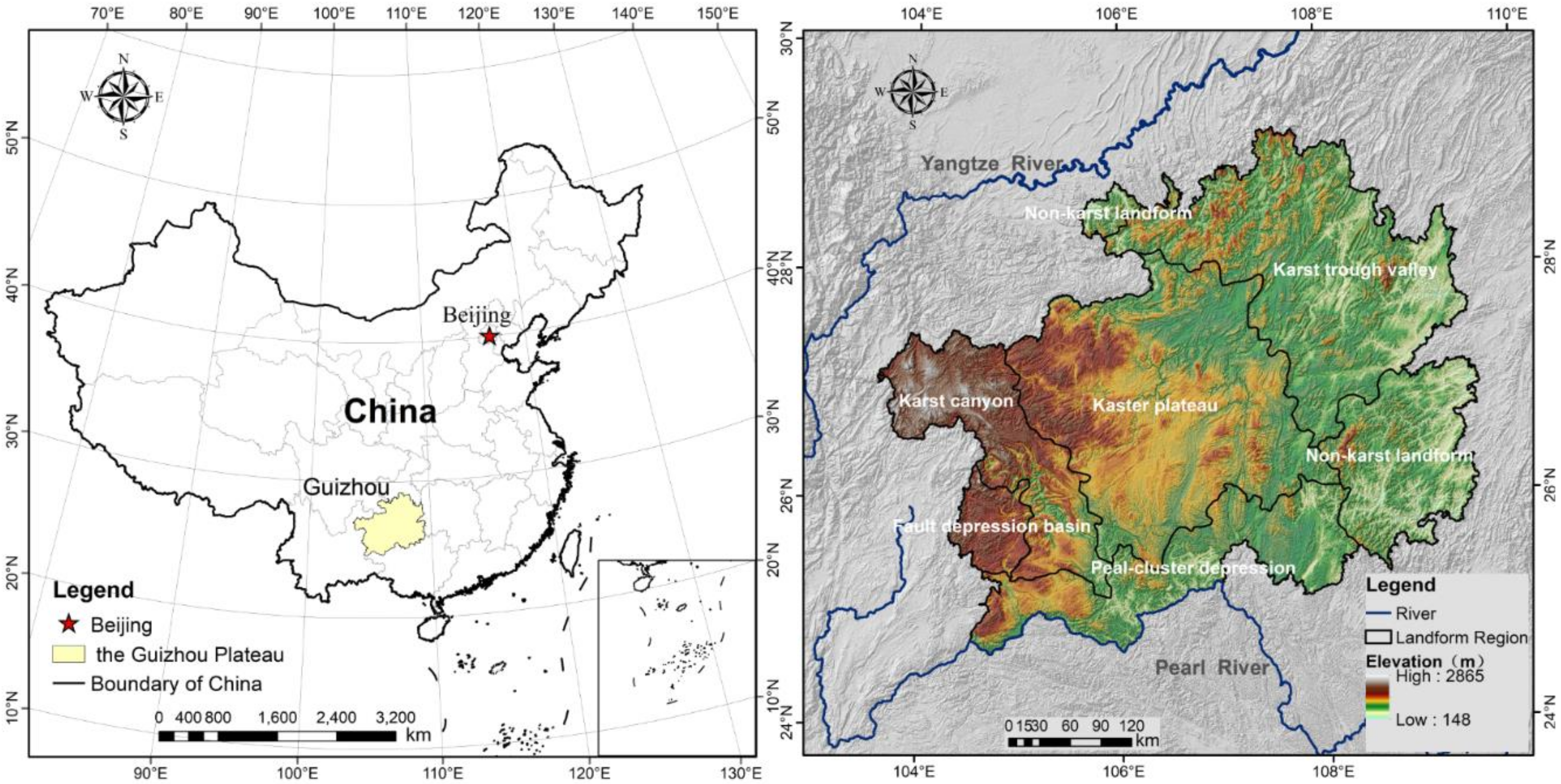

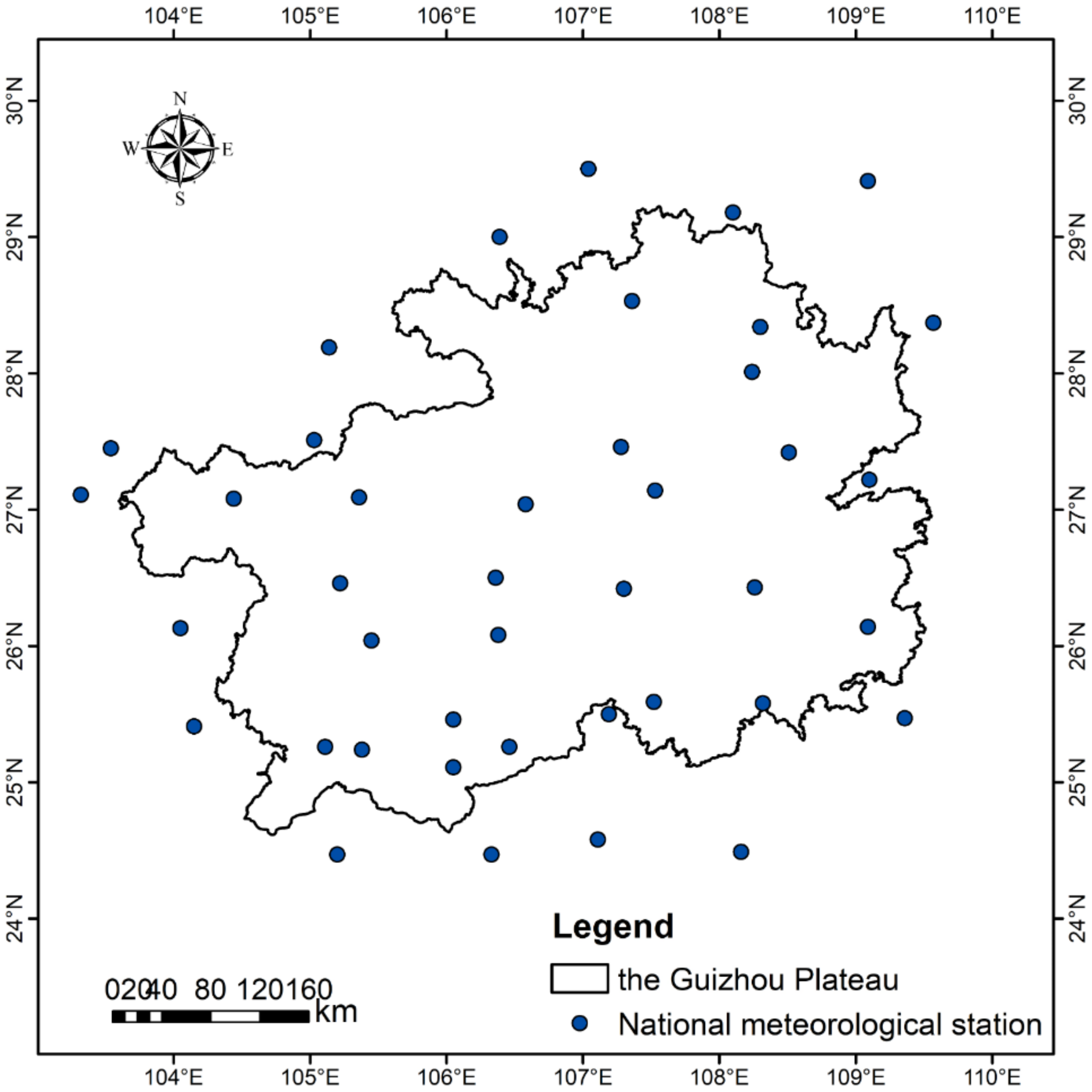
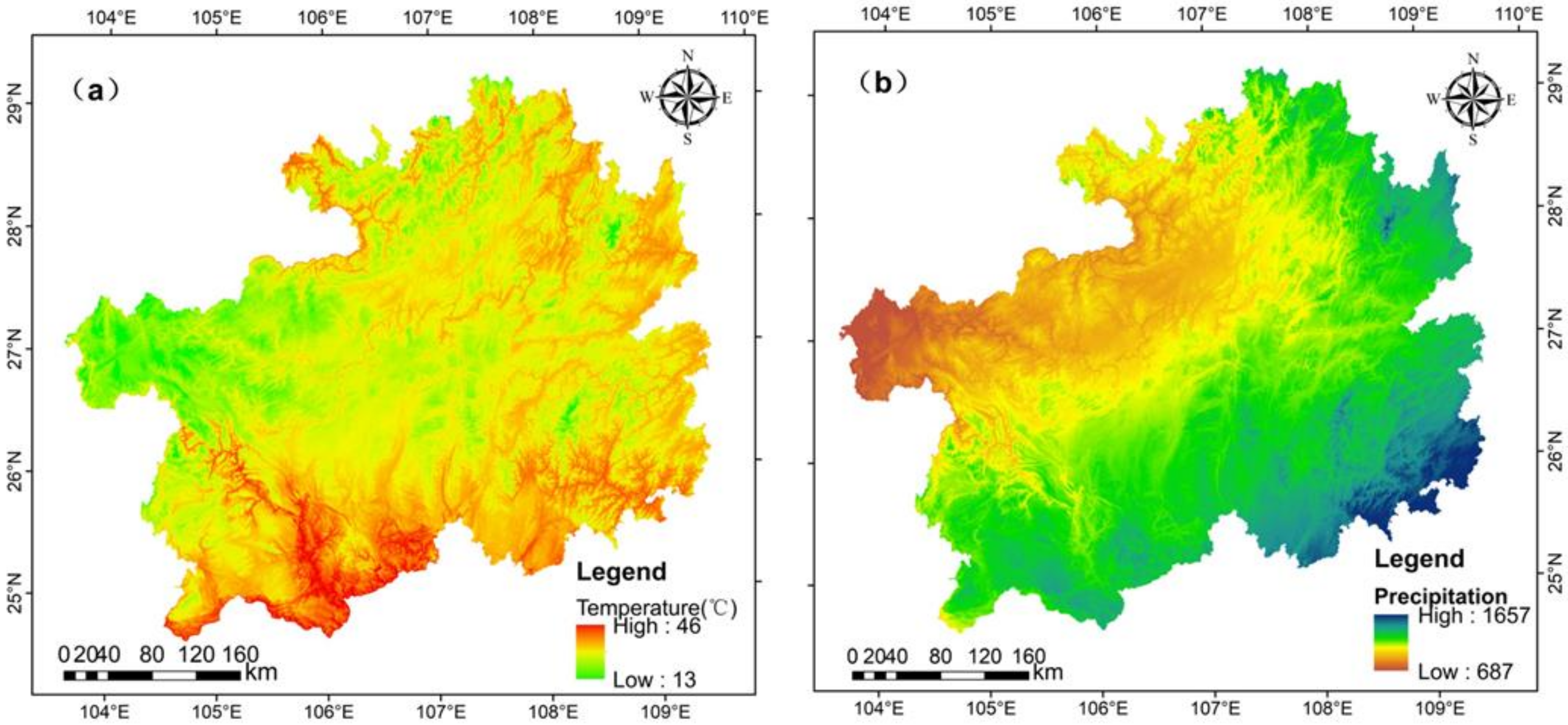
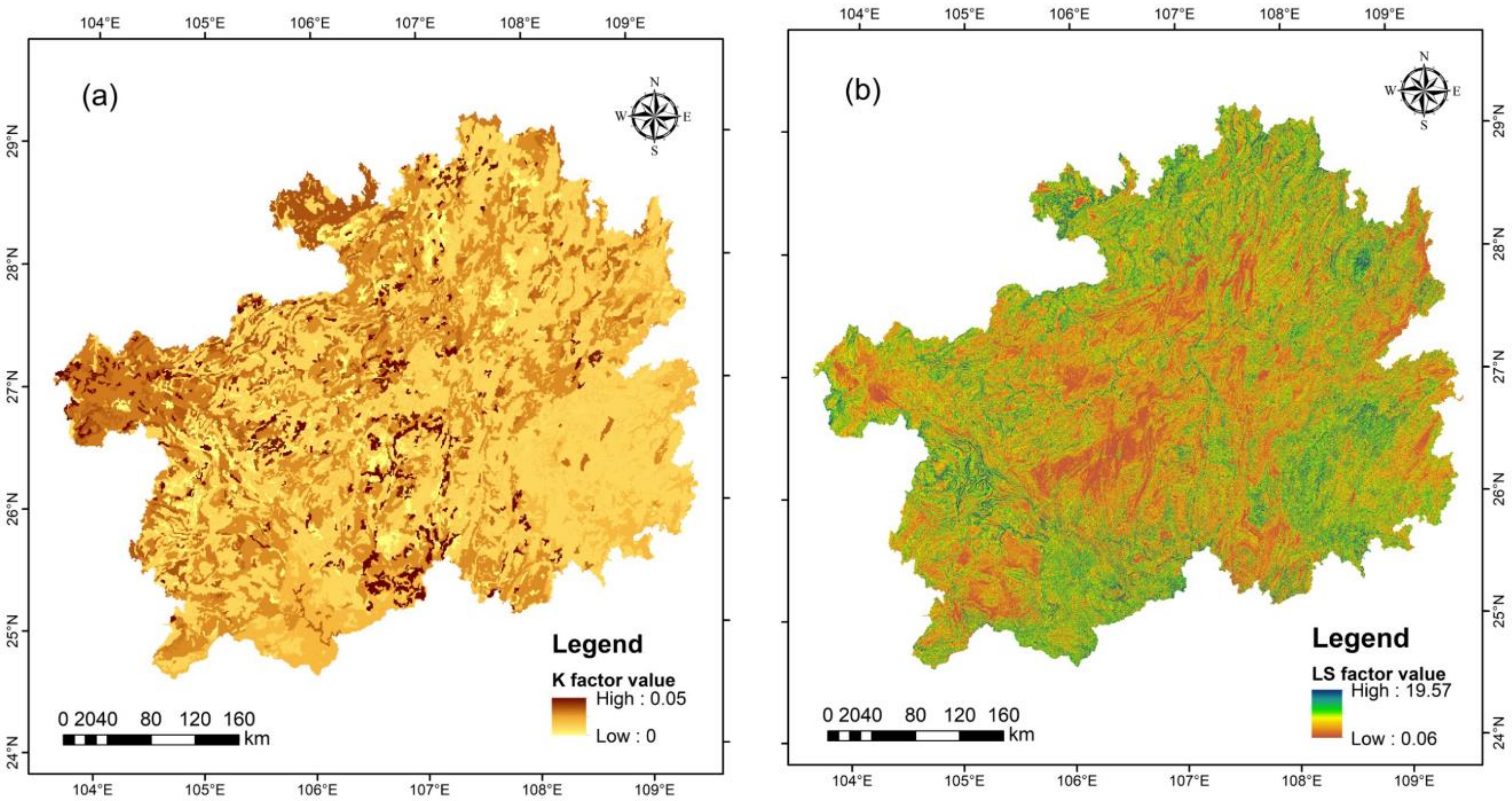
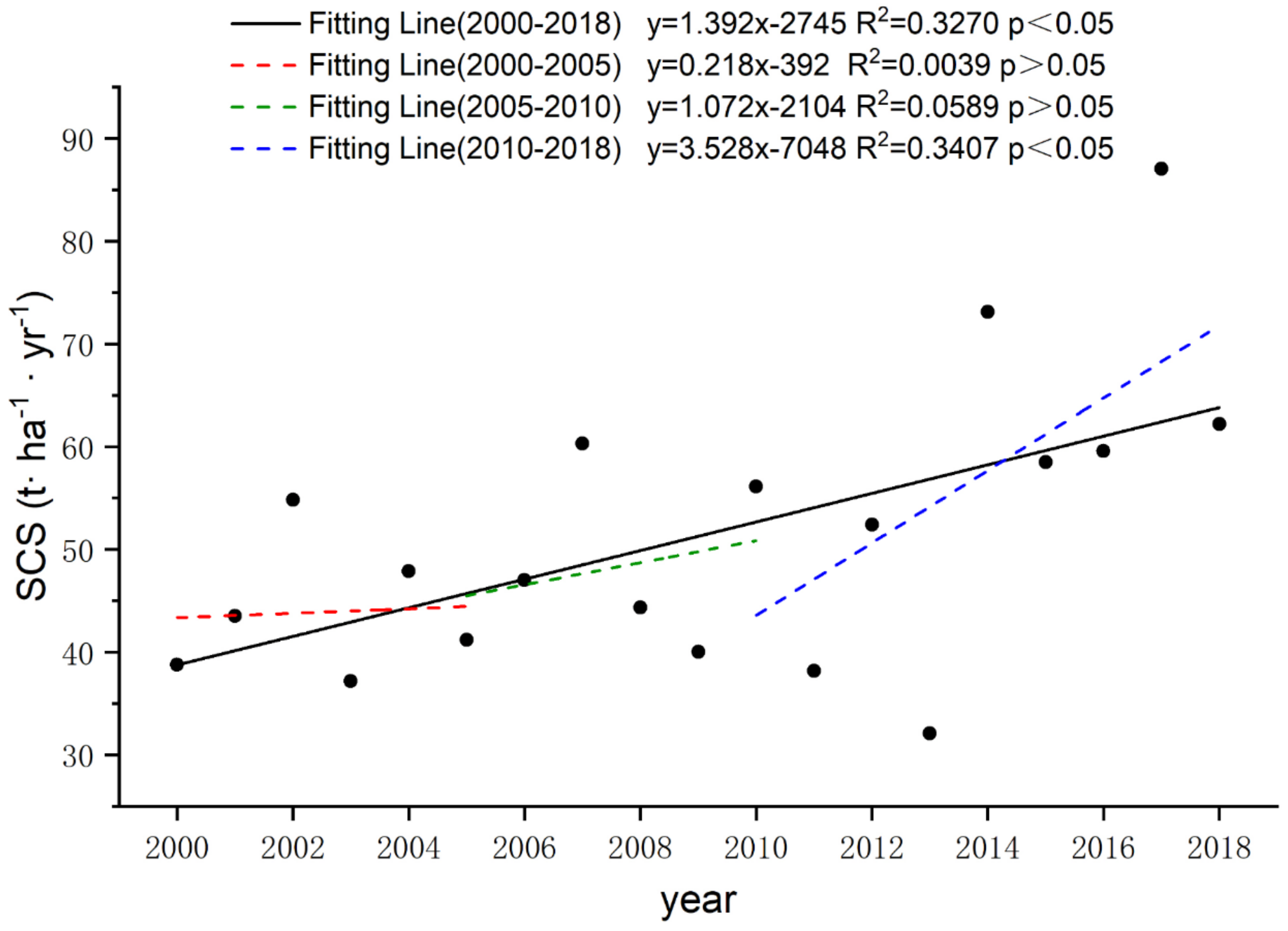
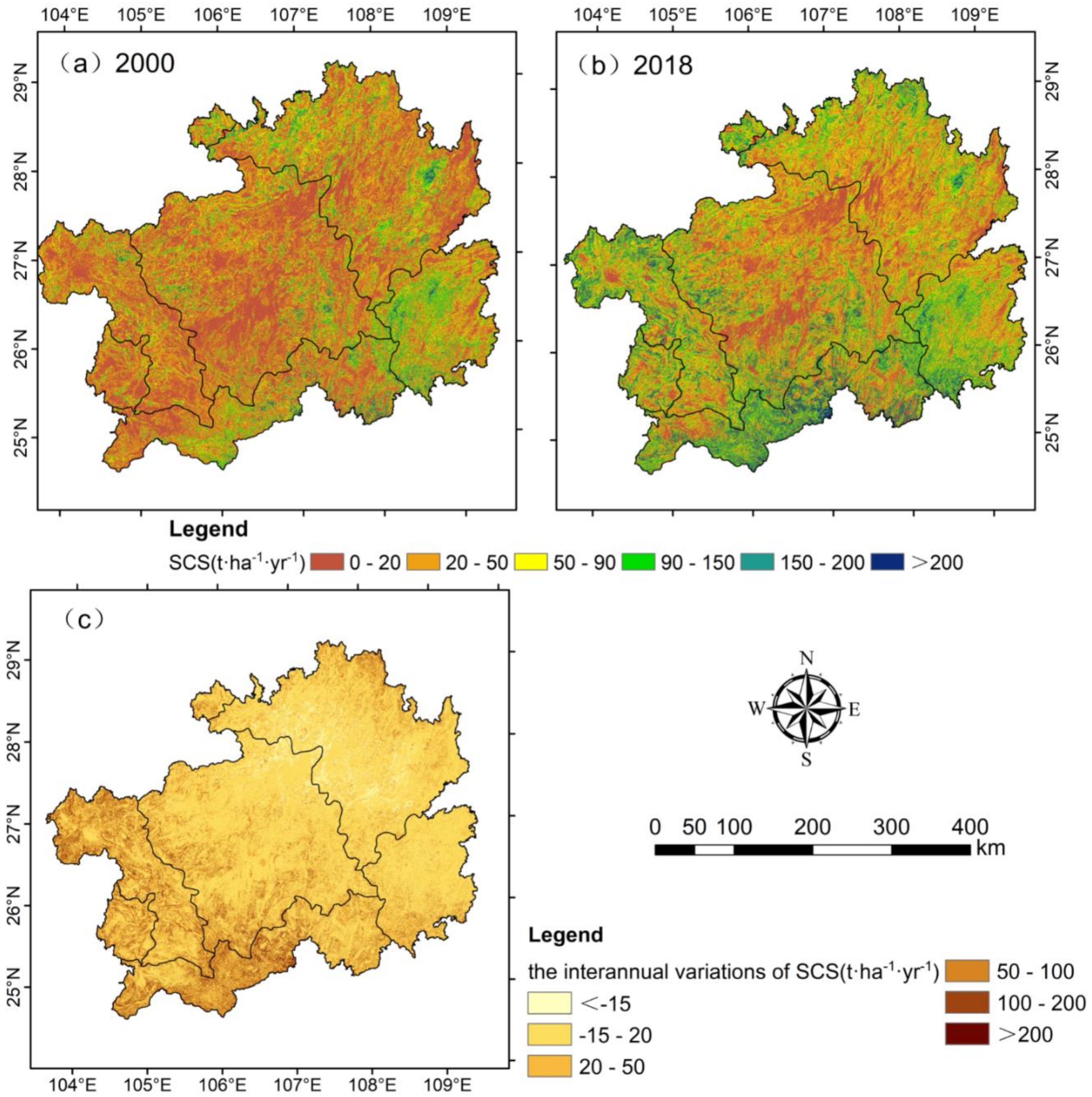
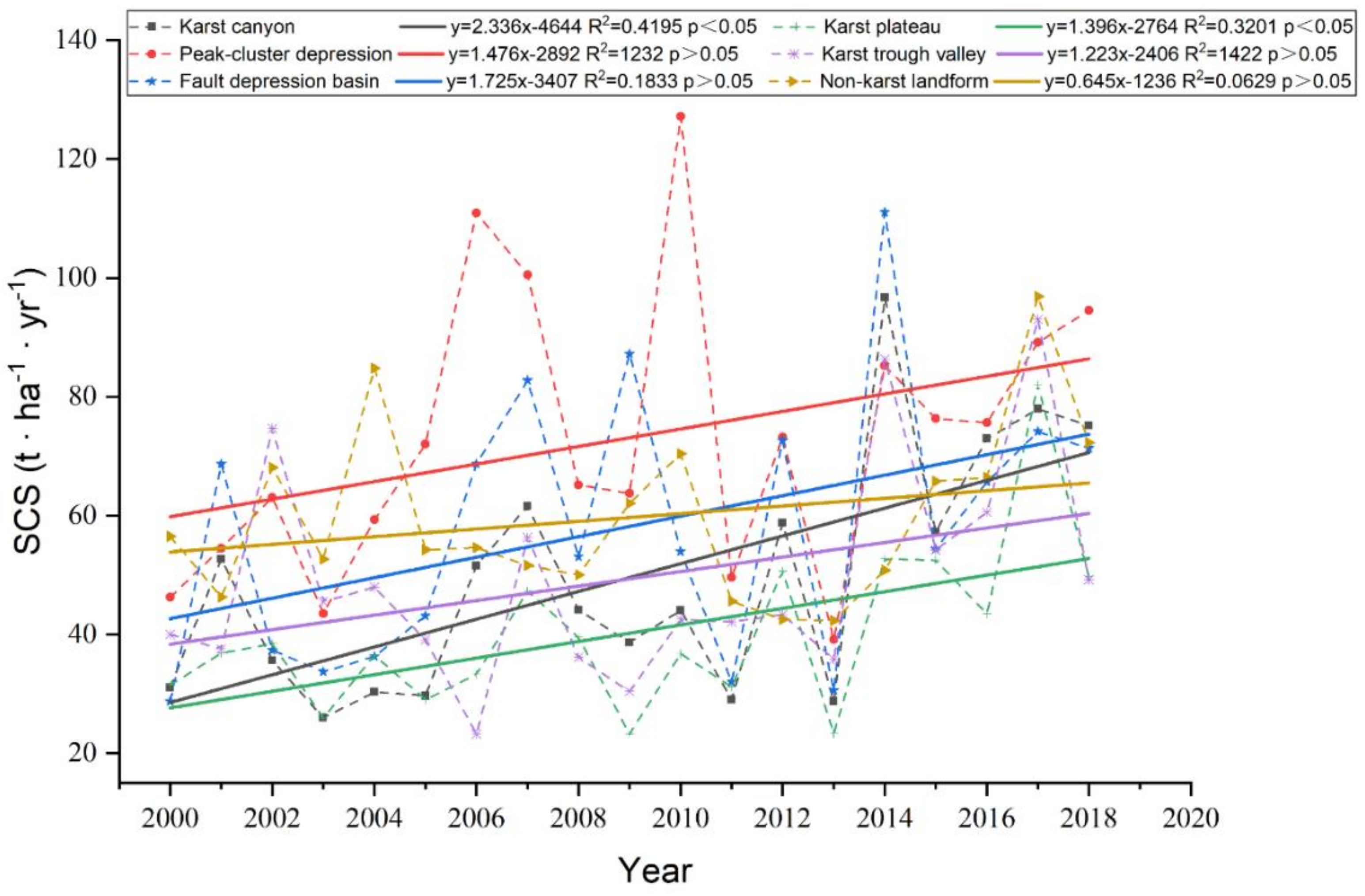


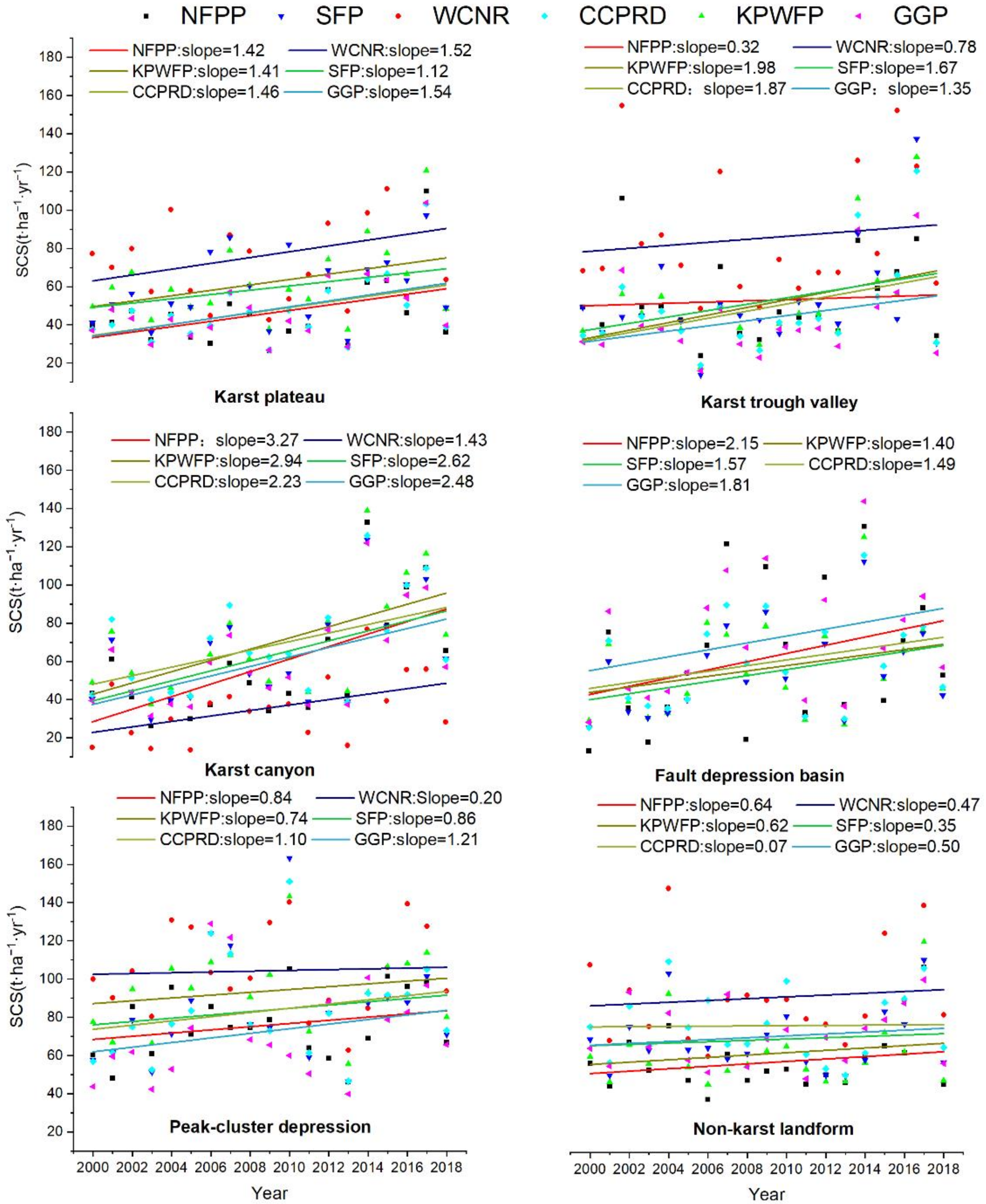
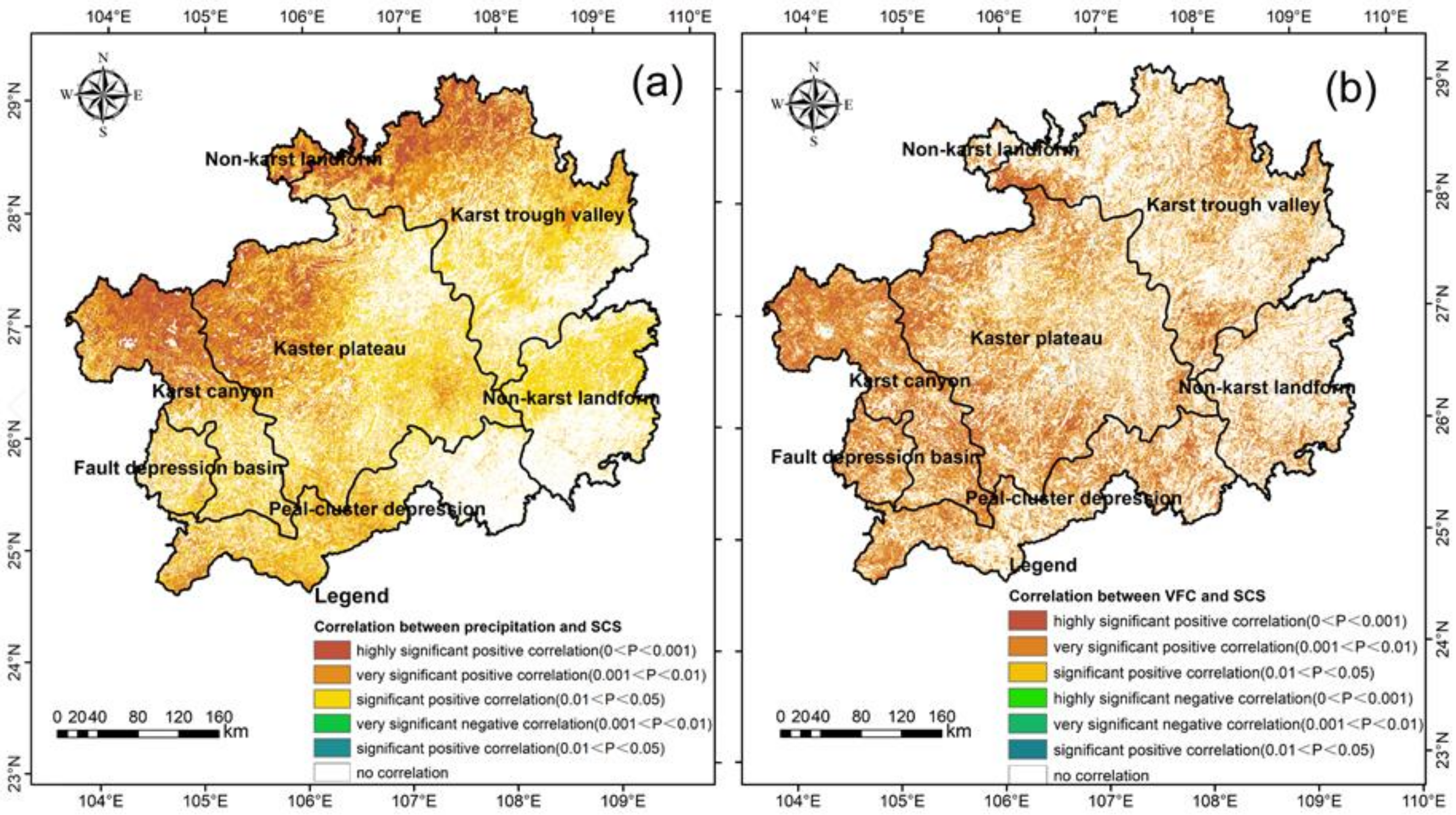
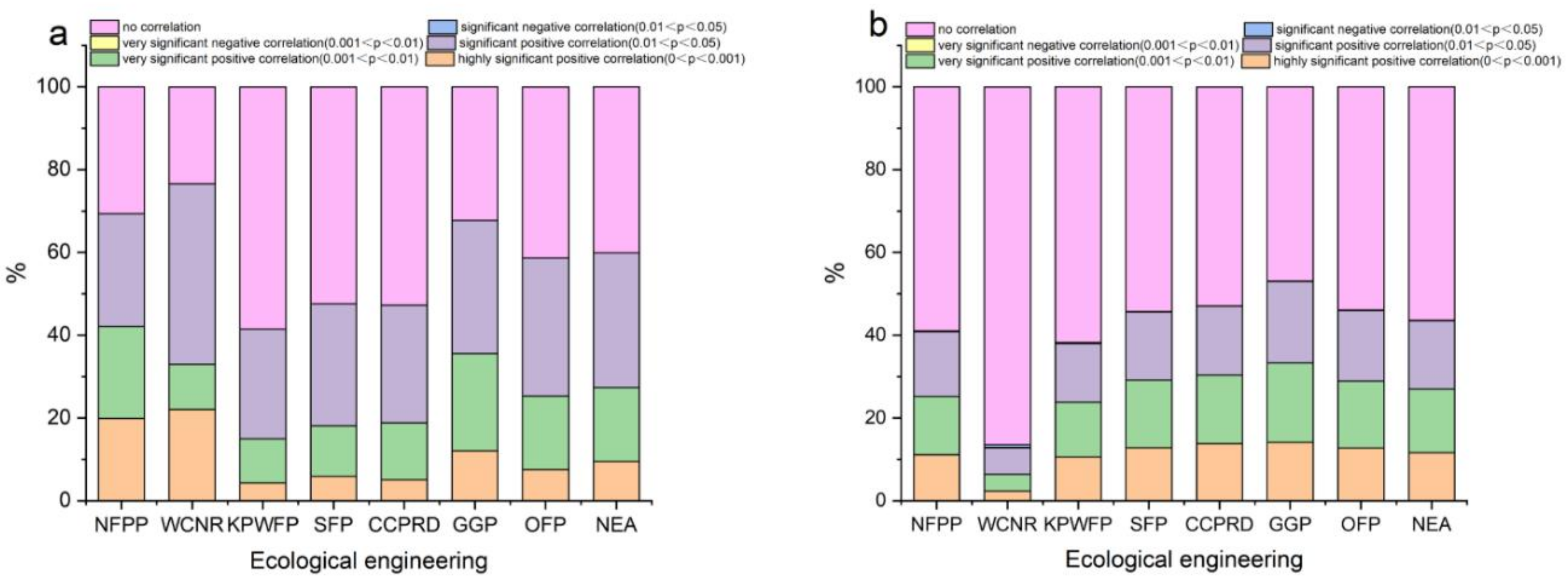
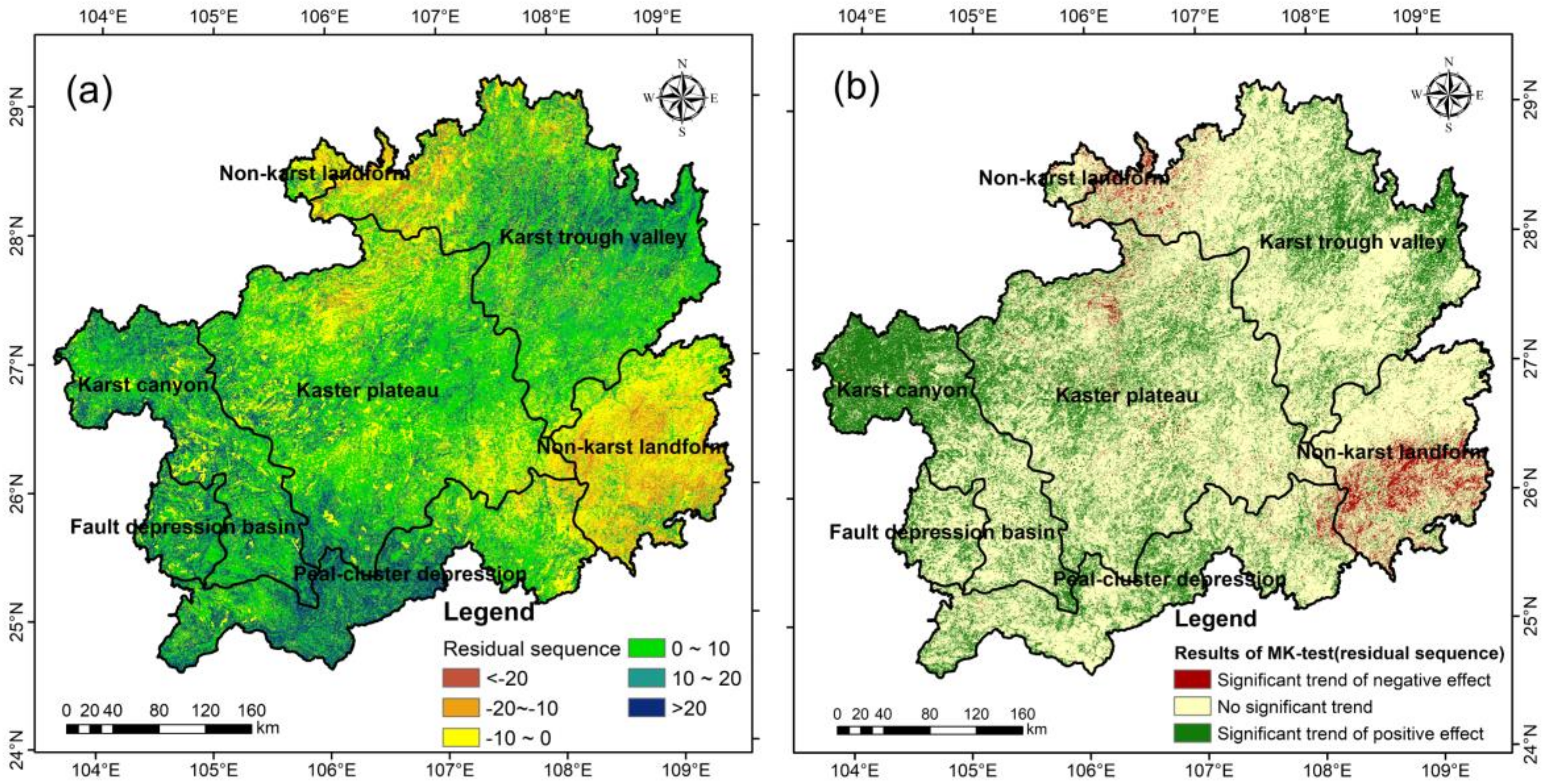
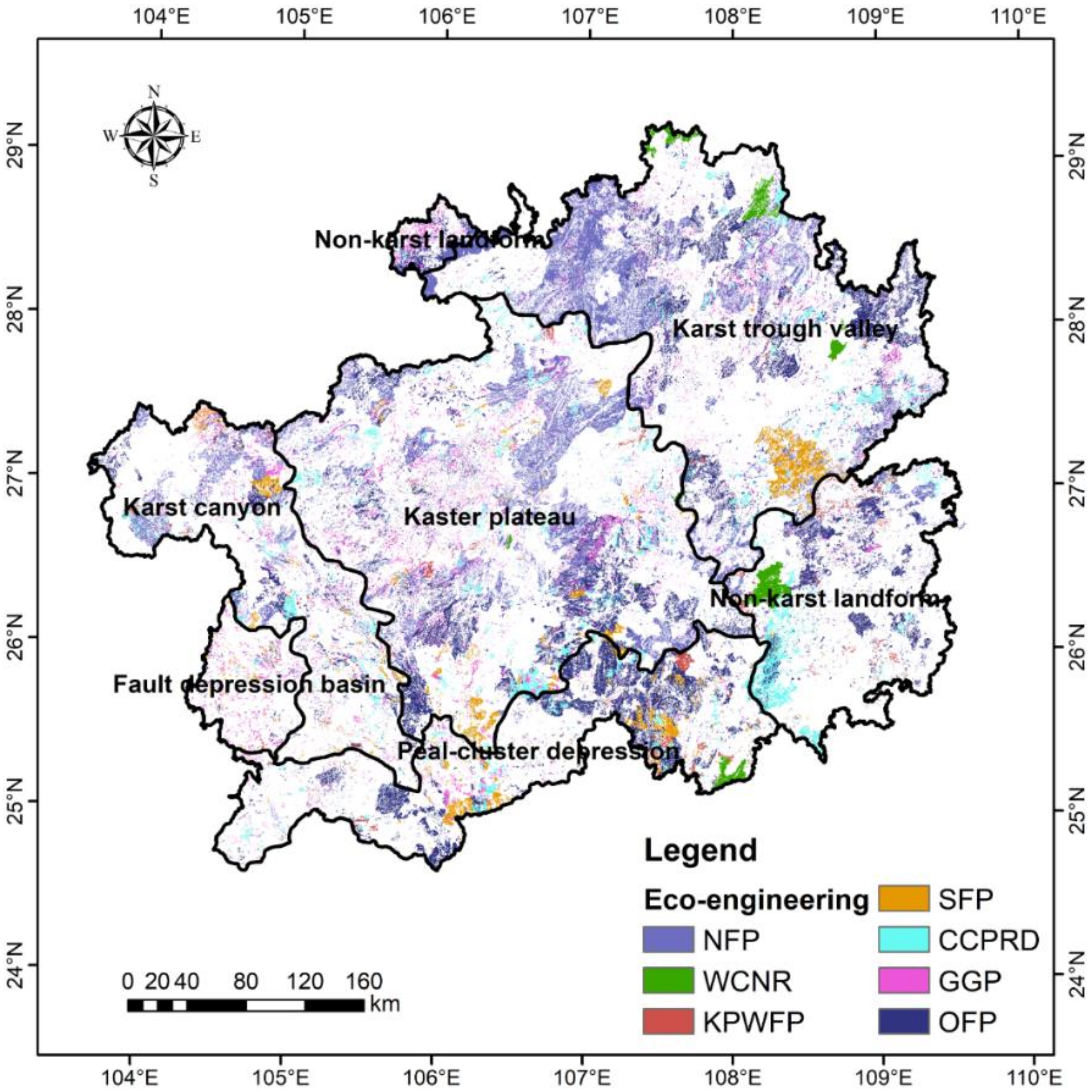

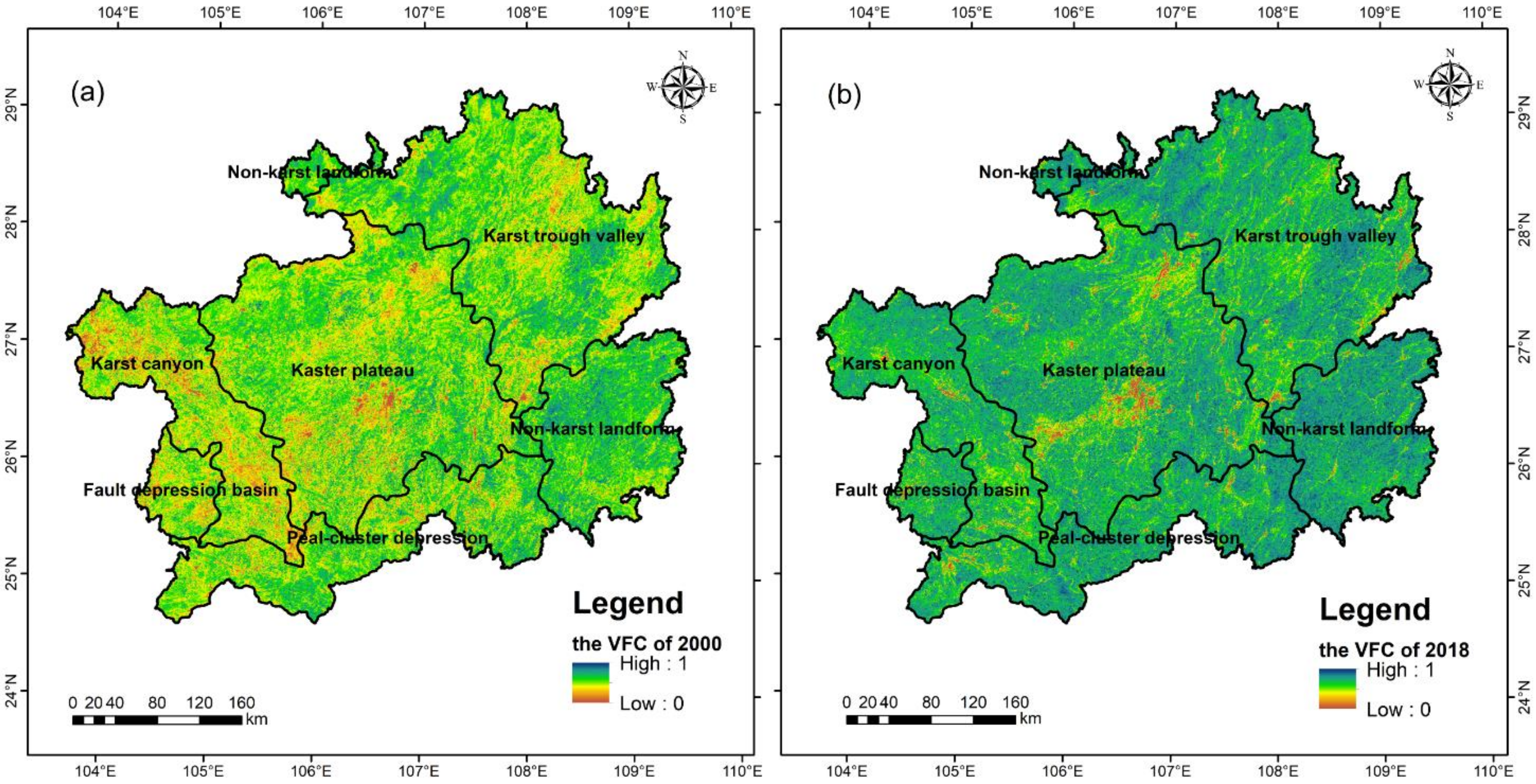
| Data Type | Resolution or Spatial Distribution | Data Source |
|---|---|---|
| Meteorological data (precipitation and temperature) | 40 points | National Meteorological Information Center |
| Soil data | 1:1,000,000 | Resource and Environment Data Cloud Platform |
| SRTM-DEM | 90 m | Computer Network Information Center, CAS |
| MODIS-NDVI | 250 m | Computer Network Information Center, CAS |
| Land use dataset | 1 km | Institute of Geographic Sciences and Natural Resources Research, CAS |
| The boundary of Eco-engineering | shapefile | Department of Forestry of Guizhou Province |
| Land Use | Paddyland | Dryland | Woodland | Grassland | Waters | Construction Land | Unused Land |
|---|---|---|---|---|---|---|---|
| P | 0.15 | 0.5 | 1 | 1 | 0 | 0 | 0 |
| SCS t·ha−1·yr−1 | Karst Canyon | Peak-Cluster Depression | Fault Depression Basin | Karst Plateau | Karst Trough Valley | Non-Karst Landform |
|---|---|---|---|---|---|---|
| Value | 49.59 | 73.12 | 59.19 | 40.22 | 49.38 | 59.69 |
| Eco-Engineering | Area km2 | Proportion of the Total Area % | SCS t·ha−1·yr−1 | Total Amount of SCS 104 t |
|---|---|---|---|---|
| NFPP | 12,688.50 | 7.20 | 42.66 | 5412.82 |
| WCNR | 1246.31 | 0.71 | 77.44 | 965.17 |
| KPWFP | 932.00 | 0.53 | 61.74 | 575.37 |
| SFP | 2634.94 | 1.50 | 53.7 | 1414.87 |
| CCPRD | 3964.75 | 2.25 | 52.65 | 2087.34 |
| GGP | 5296.38 | 3.01 | 45.37 | 2402.94 |
| Eco-Engineering | NFPP | WCNR | KPWFP | SFP | CCPRD | GGP | OFP |
|---|---|---|---|---|---|---|---|
| Average annual residual | 3.4 | −3.11 | 4.46 | 10.21 | 6.05 | 9.45 | 7.04 |
| Landform | Karst Plateau | Karst Canyon | Fault Depression Basin | Peak-Cluster Depression | Karst Trough Valley | Non-Karst Landform |
| 2000 | 0.75 | 0.72 | 0.74 | 0.77 | 0.77 | 0.81 |
| 2018 | 0.80 | 0.79 | 0.80 | 0.82 | 0.81 | 0.84 |
| Eco-Engineering | NFPP | WCNR | GGP | SFP | CCPRD | KPWFP |
| 2000 | 0.78 | 0.84 | 0.76 | 0.78 | 0.78 | 0.79 |
| 2018 | 0.83 | 0.83 | 0.84 | 0.83 | 0.83 | 0.82 |
© 2020 by the authors. Licensee MDPI, Basel, Switzerland. This article is an open access article distributed under the terms and conditions of the Creative Commons Attribution (CC BY) license (http://creativecommons.org/licenses/by/4.0/).
Share and Cite
Niu, L.; Shao, Q. Soil Conservation Service Spatiotemporal Variability and Its Driving Mechanism on the Guizhou Plateau, China. Remote Sens. 2020, 12, 2187. https://doi.org/10.3390/rs12142187
Niu L, Shao Q. Soil Conservation Service Spatiotemporal Variability and Its Driving Mechanism on the Guizhou Plateau, China. Remote Sensing. 2020; 12(14):2187. https://doi.org/10.3390/rs12142187
Chicago/Turabian StyleNiu, Linan, and Quanqin Shao. 2020. "Soil Conservation Service Spatiotemporal Variability and Its Driving Mechanism on the Guizhou Plateau, China" Remote Sensing 12, no. 14: 2187. https://doi.org/10.3390/rs12142187
APA StyleNiu, L., & Shao, Q. (2020). Soil Conservation Service Spatiotemporal Variability and Its Driving Mechanism on the Guizhou Plateau, China. Remote Sensing, 12(14), 2187. https://doi.org/10.3390/rs12142187





